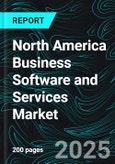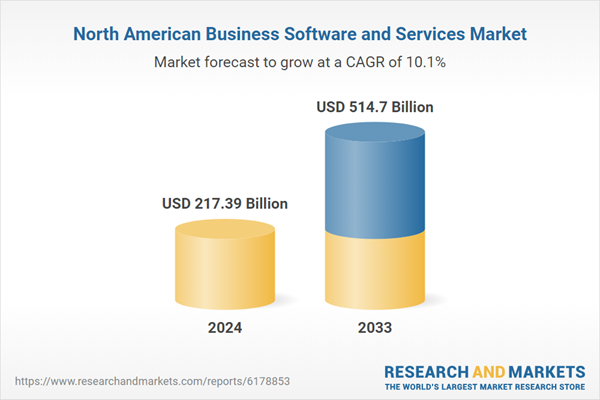North America Business Software and Services Industry Overview
Digital tools, platforms, and expert solutions that support organizational operations, boost productivity, and improve decision-making are all included in business software and services. These consist of cloud solutions, cybersecurity services, productivity software, human resources management systems (HRMS), CRM, ERP, and IT consultancy. They help companies automate repetitive processes, efficiently manage data, optimize workflows, and improve departmental cooperation. Implementation, customization, maintenance, training, and technical support are all examples of service components. Business software and services are crucial for modern firms because they allow organizations to maximize performance, maintain regulatory compliance, and obtain a competitive edge in quickly changing markets.The growing digital transformation activities by companies and SMBs seeking operational efficiency are driving growth in the North American business software and services industry. Adoption of cloud computing enables software deployment that is flexible, scalable, and economical. Intelligent decision-making, process optimization, and increased productivity are all made possible by the integration of automation with AI. The need for productivity, communication, and collaboration technologies is being driven by the growth of remote and hybrid work models. Organizations are compelled to invest in strong software solutions due to cybersecurity concerns and regulatory compliance obligations. Adoption of business intelligence and data analytics also makes it possible to make well-informed strategic choices. The market is expanding due to ongoing technical developments and the rising need for specialized, end-to-end IT solutions.
Growth Drivers for the North America Business Software and Services Market
Cloud Computing Adoption
The market for corporate software and services in North America is expanding rapidly thanks to cloud computing's scalability, affordability, and flexibility. Businesses may lower the cost of IT infrastructure, scale operations in response to demand, and swiftly implement software solutions. Waters Corporation introduced waters_connect Data Intelligence software in November 2024. This cloud-based tool helps clients in regulated industries increase laboratory data accessibility, management, and analysis, which in turn increases productivity. Businesses may make quicker, data-driven choices by implementing cloud adoption, which also facilitates remote collaboration, data storage, and the integration of advanced analytics tools. Growing demand for cloud-based business apps, Infrastructure-as-a-Service (IaaS), and Software-as-a-Service (SaaS) across industries is driving market expansion as companies seek for flexible, safe, and affordable technology solutions.Automation and AI Integration
The market for business software and services in North America is changing due to automation and artificial intelligence (AI). Businesses use automation and artificial intelligence (AI) to improve decision-making, decrease human error, and streamline processes. Chatbots, intelligent workflow tools, and analytics driven by AI improve productivity, customer satisfaction, and efficiency. By automating monotonous processes like data input, report production, and inventory management, businesses can free up staff members to work on key projects. The adoption of AI and automation across sectors is driven by the need to manage massive volumes of data and the increasing demand for sophisticated, industry-specific software solutions. Businesses can obtain faster processing, predictive insights, and increased operational efficiency by integrating AI capabilities with business software. For this reason, automation and AI are essential growth drivers.Remote and Hybrid Work Trends
In North America, the need for business software and services is growing faster due to the popularity of remote and hybrid work patterns. Tools that facilitate communication, teamwork, project management, and productivity for remote workers are necessary for organizations. While integrated systems preserve workflow efficiency across locations, cloud-based solutions, video conferencing platforms, and collaboration software facilitate smooth remote operations. Additionally, businesses are spending money on scalable, secure solutions to safeguard confidential information and guarantee business continuity. Businesses are prioritizing software that allows flexibility without sacrificing productivity as a result of the hybrid work paradigm, which is propelling the adoption of sophisticated cloud, management, and communication solutions. The need for remote-friendly company software and services is only increasing as flexible work schedules become more commonplace.Challenges in the North America Business Software and Services Market
Data Security & Privacy Concerns
One of the biggest obstacles facing the North American corporate software and services market is data security and privacy issues. Businesses create and maintain enormous volumes of sensitive data, such as client information, financial records, and private intellectual property, as a result of the growing use of cloud computing, remote work tools, and AI-driven apps. They are therefore desirable targets for ransomware, hacks, and data breaches. Complying with stringent laws like the CCPA, GDPR, and HIPAA increases complexity and necessitates that companies and software suppliers put strong security measures in place. Financial damages, harm to one's reputation, and legal repercussions might result from not securing data. As a result, businesses need to make large investments in encryption, safe access controls, advanced cybersecurity measures, and ongoing monitoring. This raises operating costs and makes it difficult to produce scalable, secure software solutions.High Implementation Costs
A significant challenge facing the North American corporate software and services market is high implementation costs. Large upfront expenditures for infrastructure, customization, licensing, and system integration are frequently required when deploying corporate software. Regular software updates, continuous technical support, and staff training must also be funded by organizations. Small and medium-sized enterprises with tight budgets may find these costs especially onerous, which could impede the uptake of cutting-edge solutions like ERP, CRM, or AI-powered platforms. Furthermore, lengthy delays, extra consultancy costs, and operational disruptions might result from difficult installations. It is still very difficult for providers to control these expenses while still offering scalable, effective, and efficient software solutions; this calls for phased rollout strategies, cost optimization, and strategic planning.United States Business Software and Services Market
The United States is the largest and most mature market for business software and services in North America, driven by advanced digital transformation initiatives, widespread cloud adoption, and robust technological infrastructure. Enterprises of all sizes are investing in software solutions such as ERP, CRM, HRMS, AI analytics, and cybersecurity services to enhance operational efficiency, decision-making, and competitiveness. The rise of remote and hybrid work models has further accelerated demand for collaboration, communication, and productivity tools. Strong adoption of AI, automation, and data analytics, along with high disposable income and technology spending, supports market growth. Additionally, the U.S. market benefits from a large pool of skilled IT professionals and innovative startups, making it a key driver of innovation in the region.Canada Business Software and Services Market
Canada’s business software and services market is expanding steadily, driven by digital transformation across enterprises and SMBs, growing cloud adoption, and government initiatives promoting technology integration. Organizations increasingly rely on software solutions for operational efficiency, regulatory compliance, data analytics, and cybersecurity. Remote and hybrid work trends have accelerated the adoption of collaboration and productivity tools. Canada’s multicultural workforce and strong IT ecosystem support innovation and implementation of AI, automation, and cloud-based solutions. Despite being smaller than the U.S. market, Canada demonstrates a high growth potential due to increasing technology spending, demand for scalable software services, and rising awareness of digital solutions among businesses seeking efficiency, cost optimization, and competitive advantage in both domestic and international markets.Recent Developments in North America Business Software and Services Market
- In January 2025, Izzi Software completed the acquisition of ColeSoft, a Virginia-based developer of debugging products for software engineers and support staff working on IBM mainframes. The company is also actively exploring additional acquisitions in the enterprise software sector to strengthen its market presence.
- In October 2024, Stem Inc., a global leader in AI-enabled clean energy software and services, announced a new strategy-driven software solution. The platform is designed to enhance scalable growth, increase profitability, and drive predictable recurring revenue with higher gross margins for its clients.
- In October 2024, Acumatica, Inc. launched its Professional Services Edition, targeting small and midsized professional services firms. The solution offers industry-specific features for architecture, engineering, IT, and other sectors, helping organizations optimize workflows, enhance collaboration, improve operational performance, and accelerate overall business growth.
North America Business Software and Services Market Segments:
Software
- Finance
- Sales & Marketing
- Human Resource
- Supply Chain
- Others
Service
- Consulting
- Managed Services
- Support & Maintenance
Deployment
- Cloud
- On-premise
Enterprise
- Large Enterprises
- Small & Medium Enterprises
End Use
- Aerospace & Defense
- BFSI
- Government
- Healthcare
- IT & Telecom
- Manufacturing
- Retail
- Transportation
- Others
Country
- United States
- Canada
All companies have been covered from 5 viewpoints:
- Company Overview
- Key Persons
- Recent Development & Strategies
- SWOT Analysis
- Sales Analysis
Key Players Analysis
- Acumatica, Inc.
- SAP SE
- Deltek, Inc.
- IBM Corporation
- Infor
- Microsoft
- Epicor Software Corporation
- NetSuite Inc.
- Oracle
- MicroStrategy Incorporated
Table of Contents
Companies Mentioned
- Acumatica, Inc.
- SAP SE
- Deltek, Inc.
- IBM Corporation
- Infor
- Microsoft
- Epicor Software Corporation
- NetSuite Inc.
- Oracle
- MicroStrategy Incorporated
Methodology
In this report, for analyzing the future trends for the studied market during the forecast period, the publisher has incorporated rigorous statistical and econometric methods, further scrutinized by secondary, primary sources and by in-house experts, supported through their extensive data intelligence repository. The market is studied holistically from both demand and supply-side perspectives. This is carried out to analyze both end-user and producer behavior patterns, in the review period, which affects price, demand and consumption trends. As the study demands to analyze the long-term nature of the market, the identification of factors influencing the market is based on the fundamentality of the study market.
Through secondary and primary researches, which largely include interviews with industry participants, reliable statistics, and regional intelligence, are identified and are transformed to quantitative data through data extraction, and further applied for inferential purposes. The publisher's in-house industry experts play an instrumental role in designing analytic tools and models, tailored to the requirements of a particular industry segment. These analytical tools and models sanitize the data & statistics and enhance the accuracy of their recommendations and advice.
Primary Research
The primary purpose of this phase is to extract qualitative information regarding the market from the key industry leaders. The primary research efforts include reaching out to participants through mail, tele-conversations, referrals, professional networks, and face-to-face interactions. The publisher also established professional corporate relations with various companies that allow us greater flexibility for reaching out to industry participants and commentators for interviews and discussions, fulfilling the following functions:
- Validates and improves the data quality and strengthens research proceeds
- Further develop the analyst team’s market understanding and expertise
- Supplies authentic information about market size, share, growth, and forecast
The researcher's primary research interview and discussion panels are typically composed of the most experienced industry members. These participants include, however, are not limited to:
- Chief executives and VPs of leading corporations specific to the industry
- Product and sales managers or country heads; channel partners and top level distributors; banking, investment, and valuation experts
- Key opinion leaders (KOLs)
Secondary Research
The publisher refers to a broad array of industry sources for their secondary research, which typically includes, however, is not limited to:
- Company SEC filings, annual reports, company websites, broker & financial reports, and investor presentations for competitive scenario and shape of the industry
- Patent and regulatory databases for understanding of technical & legal developments
- Scientific and technical writings for product information and related preemptions
- Regional government and statistical databases for macro analysis
- Authentic new articles, webcasts, and other related releases for market evaluation
- Internal and external proprietary databases, key market indicators, and relevant press releases for market estimates and forecasts

LOADING...
Table Information
| Report Attribute | Details |
|---|---|
| No. of Pages | 200 |
| Published | September 2025 |
| Forecast Period | 2024 - 2033 |
| Estimated Market Value ( USD | $ 217.39 Billion |
| Forecasted Market Value ( USD | $ 514.7 Billion |
| Compound Annual Growth Rate | 10.0% |
| Regions Covered | North America |
| No. of Companies Mentioned | 10 |









